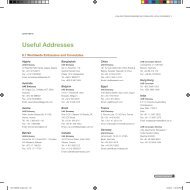Arab World Competitiveness Report 2011-2012 - World Economic ...
Arab World Competitiveness Report 2011-2012 - World Economic ...
Arab World Competitiveness Report 2011-2012 - World Economic ...
Create successful ePaper yourself
Turn your PDF publications into a flip-book with our unique Google optimized e-Paper software.
1. A Time of Opportunities: The <strong>Competitiveness</strong> Performance of the <strong>Arab</strong> <strong>World</strong><br />
<strong>Arab</strong> <strong>World</strong> <strong>Competitiveness</strong> <strong>Report</strong> <strong>2011</strong>-<strong>2012</strong><br />
Box 1: Overcoming the Employment<br />
Challenge by Raising <strong>Competitiveness</strong><br />
Over the past several decades, most countries in the<br />
<strong>Arab</strong> world have relied on the government and on<br />
state enterprises for employment creation. While this<br />
was an expedient way to create jobs in the shorter<br />
term, over the longer term, rapid population growth<br />
has made it impossible for the public sector to provide<br />
a sufficient number of jobs, in particular for the young<br />
people entering the labor market.* At the same time,<br />
the business sector has not been able to fill the gap,<br />
as it remained stifled by a business environment that<br />
did not encourage private sector growth. As a result,<br />
unemployment has risen in many countries over recent<br />
decades. Currently, regional unemployment rates are<br />
the highest worldwide, with women and youth most<br />
severely affected (see chapter 2 for a more detailed<br />
account of unemployment levels). †<br />
Population growth had already begun to slow prior<br />
to the economic boom that ended in 2008, reducing<br />
unemployment, However, the subsequent slowdown<br />
pushed regional unemployment back up to 10.3 percent<br />
in 2010, and is expected to remain high, at 10.0 percent<br />
in <strong>2011</strong>. ‡<br />
In this context, the <strong>Arab</strong> region is in need of economic<br />
growth that is based on a vibrant and growing private<br />
sector if it is to attain durably higher levels of gainful<br />
employment: only the private sector can create a<br />
sufficient number of jobs in a sustainable manner. Figure<br />
1 shows that, according to business leaders, restrictive<br />
labor regulations, inefficient bureaucracy, and a lack of<br />
access to finance are the top three hindrances to doing<br />
business in the region.<br />
The Global <strong>Competitiveness</strong> Index (GCI) sheds light<br />
on some of the major stumbling blocks to achieving<br />
higher levels of employment over the longer term.<br />
More competitive economies are those that have in<br />
place factors, policies, and institutions that enable<br />
higher productivity. Higher productivity, in turn, tends<br />
to translate into higher employment in the context of<br />
rising demand. In the MENA region, given the untapped<br />
potential of domestic and export markets, § higher<br />
productivity should translate into increased employment,<br />
in addition to wage increases and rising standards of<br />
living.<br />
Despite the significant differences among <strong>Arab</strong><br />
countries, some common trends emerge when<br />
comparing the results from national competitiveness<br />
indicators. Figure 2 shows the disparities between the<br />
best- and worst-performing countries in the region. The<br />
performances of the sub-regions are also shown, as is<br />
the European Union (EU) average, for comparison.<br />
10<br />
Figure 1: The most problematic factors for doing business in the <strong>Arab</strong> world<br />
Access to financing<br />
Restrictive labor regulations<br />
Inefficient government bureaucracy<br />
Inadequately educated workforce<br />
Corruption<br />
Poor work ethic in national labor force<br />
Inadequate supply of infrastructure<br />
Policy instability<br />
Government instability/coups<br />
Inflation<br />
Tax rates<br />
Tax regulations<br />
Foreign currency regulations<br />
Poor public health<br />
Crime and theft<br />
1.2<br />
1.0<br />
4.5<br />
4.2<br />
4.0<br />
3.5<br />
3.2<br />
8.8<br />
7.5<br />
7.2<br />
6.1<br />
13.9<br />
12.4<br />
11.6<br />
10.9<br />
0 5 10 15 20<br />
Source: <strong>World</strong> <strong>Economic</strong> Forum, Executive Opinion Survey <strong>2011</strong><br />
* See <strong>World</strong> Bank 2003 for a detailed historical analysis of employment in the region.<br />
†<br />
See ILO <strong>2011</strong>.<br />
‡<br />
ILO <strong>2011</strong>.<br />
§<br />
See <strong>World</strong> <strong>Economic</strong> Forum 2010 for more details on the export potential of the region.





